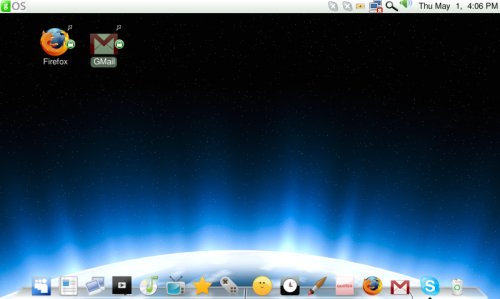I Take it Back: gOS Space Could Save the CloudBook
I wrote a few weeks ago about the potential that gOS Space had to improve the CloudBook experience. Unfortunately, my installation of gOS Space failed at the time. However, I received a comment on that post from David Lui, the father of the gOS operating system. He kindly offered to send me a gOS Space build made specifically for the CloudBook.
Today I got around to installing the sleek Linux OS on our battered CloudBook. I say this with a lot of joy: It hands-down improves the CloudBook experience. Like Jeff thought in his initial hands-on with gOS Space, the OS is really sleek and its rip-off OS X components are pretty damn cool.
Installation was a breeze and, unlike our original experience with the CloudBook, all the windows are properly sized for the screen.
The OS just makes the CloudBook look a lot nicer. The icons on the bottom of the screen become illuminated and rotate when moused over, and the starry desktop just gives the system a better aura.
In the OS, the only hold-up I am having is an issue connecting over Wi-Fi. All the networks show up but I can't seem to connect. However, connected via an Ethernet cord, I am surfing like nobody's business. I love the Web stacks that pop out of the horizontal desktop tray; I can easily get to Perez Hilton and Access Hollywood's sites. (Note: What Linux users do you know that read Access Hollywood or celeb sites?)
In certain ways, however, gOS cannot save the CloudBook, because its original hardware is just too shoddy. Boot time stayed the same, at about 3 minutes. In addition, the graphics of the system still stall at points and pixelate sections of the screen.
My last peeve is that this version of gOS Space for the CloudBook isn't yet available. Besides the wireless issue, I would say this OS is ready to go and can only improve a CloudBook owner's experience.
Sign up to receive The Snapshot, a free special dispatch from Laptop Mag, in your inbox.
Joanna Stern was a laptop reviewer and writer at Laptop Mag. She reviewed notebooks big and small, including models from MSI, Asus, Toshiba, and Lenovo. This was right at the beginning of her impressive career in journalism. Since then, she's become one of the most recognizable voices in consumer tech. Joanna now works with The Wall Street Journal, and was previously a founding editor at The Verge. After Laptop Mag, she worked at Engadget as a reviews editor. Joanna has won a News & Documentary Emmy Award as well as two Gerald Loeb Awards.



